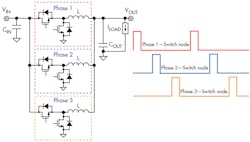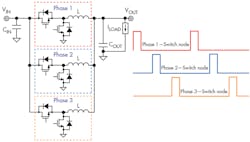Supply Meets Demand: Use Multiphase Converters to Solve Tough Power Design Challenges (.PDF Download)
No matter what the latest microprocessor, FPGA, or ASIC has in store, their demands always seem to be the same—the need for higher current while operating at lower voltages. A core voltage of less than 1 V is common. Power supplies for current-generation microprocessors must be able to supply the core with a current up to 200 A. Dynamic load variations of up to 500 A/µs are also possible. During these transients, the voltage to the processors must stay within a narrow window, often ±3%.
For lower-current applications up to approximately 40 A, single-phase buck topologies work well, but as currents increase, their efficiency declines and power dissipation becomes an issue. Combining high efficiency and fast transient response presents another problem. The transient response depends on switching frequency, but raising the frequency lowers efficiency due to increased switching losses.
The multiphase regulator has higher efficiency and faster transient response than a single buck regulator of equivalent power. A multiphase design consists of several single buck-regulator stages connected in parallel driving a common load. Each regulator stage has its own inductor and power MOSFETs, but the input and output capacitors are shared.
High-power processor applications such as servers, PC desktops, and laptops have traditionally been the primary homes for multiphase buck regulators. However, they’re becoming an attractive option for space-constrained smartphones and tablets, too, as those applications steadily increase their peak power demands.
1. Shown is a multiphase buck regulator with its three phases. (Source: TI Application Report: “Multiphase Buck Design From Start to Finish (Part 1)” PDF, p. 2)

